SunStar KM-1172BLX-7 User manual
- Category
- Sewing machines
- Type
- User manual
This manual is also suitable for

USER
S MANUAL
KM-1170 SERIES
1-Needle, Unison Feed
Lock Stitch M/C
KM-1172 SERIES
2-Needle, Unison Feed
Lock Stitch M/C
R


Best Quality
Best Price
Best Service
R
1.
Thank you for purchasing our product. Based on the rich expertise and
experience accumulated in industrial sewing machine production, SUNSTAR
will manufacture industrial sewing machines, which deliver more diverse
functions, high performance, powerful operation, enhanced durability, and
more sophisticated design to meet a number of user’s needs.
2. Please read this user’s manual thoroughly before using the machine. Make
sure to properly use the machine to enjoy its full performance.
3. The specifications of the machine are subject to change, aimed to enhance
product performance, without prior notice.
4.
This product is designed, manufactured, and sold as an industrial sewing
machine. It should not be used for other than industrial purpose.

4
Contents
1. Machine safety regulations --------------------------------------------------------------------- 6
1-1) Transporting machine --------------------------------------------------------------------------- 6
1-2) Installing machine --------------------------------------------------------------------------------- 6
1-3) Repairing machine -------------------------------------------------------------------------------- 6
1-4) Operating machine ------------------------------------------------------------------------------- 7
1-5) Safety devices ------------------------------------------------------------------------------------- 7
1-6) Caution mark position ---------------------------------------------------------------------------- 8
1-7) Contents of marks -------------------------------------------------------------------------------- 8
2. Names of main parts ------------------------------------------------------------------------------- 9
3. Specifications
--------------------------------------------------------------------------------------- 10
4. Installation
-------------------------------------------------------------------------------------------- 12
4.1) Installation place --------------------------------------------------------------------------------- 12
4.2) Machine delivery --------------------------------------------------------------------------------- 12
4.3) Bending the machine backwards ----------------------------------------------------------- 12
4.4) Table drawing ------------------------------------------------------------------------------------ 13
4.5) Installation of Sewing Machine Body ------------------------------------------------------- 15
4.6) Supplying oil -------------------------------------------------------------------------------------- 21
4.7) Trial run (Pedal operation) -------------------------------------------------------------------- 22
4.8) Machine Stop Position Check ---------------------------------------------------------------- 22
4.9) Back tack button (thread trimming type) -------------------------------------------------- 23
4.10) Functional description of function switches --------------------------------------------- 23
4.11) Adjusting Parameter of Sub Thread Adjusting Device ------------------------------- 24
4.12) How to Use Dual Tension ------------------------------------------------------------------- 24
4.13) Method for Adjustment of a Potentiometer ---------------------------------------------- 26
5. Preparations for sewing ------------------------------------------------------------------------ 27
5.1) Installing needle --------------------------------------------------------------------------------- 27
5.2) Bobbin Insertion and Removal --------------------------------------------------------------- 27
5.3) Winding lower thread --------------------------------------------------------------------------- 28
5.4) Inserting upper thread -------------------------------------------------------------------------- 28
6. Sewing -------------------------------------------------------------------------------------------------- 29
6.1) Sewing --------------------------------------------------------------------------------------------- 29
6.2) Adjusting thread tension ----------------------------------------------------------------------- 29
6.3) Adjusting upper thread length after trimming -------------------------------------------- 31
6.4) Adjustment of the stitch length --------------------------------------------------------------- 32
6.5) Adjustment of Presser Foot Lift -------------------------------------------------------------- 32

5
6.6) Adjustment of Presser Foot Pressure ------------------------------------------------------ 33
7. Inspecting and checking ---------------------------------------------------------------------- 34
7.1) Regular Check Points -------------------------------------------------------------------------- 34
7.2) Cleaning ------------------------------------------------------------------------------------------- 35
7.3) Daily Cleaning ------------------------------------------------------------------------------------ 35
8. Maintenance and repair ------------------------------------------------------------------------- 37
8.1) Adjustment of Thread Take-up Lever Spring -------------------------------------------- 37
8.2) Adjustment of Thread Guide on Thread Adjusting Device --------------------------- 38
8.3) Adjustment of Feed Dog Position ----------------------------------------------------------- 38
8.4) Height adjustment of feed dog --------------------------------------------------------------- 39
8.5) Adjustment of feed lift shaft cam and lower feed cam -------------------------------- 39
8.6) Needle and Hook Timing ---------------------------------------------------------------------- 40
8.7) Clearance adjustment of hook and opener ----------------------------------------------- 41
8.8) Lubrication adjustment of hook -------------------------------------------------------------- 41
8.9) Adjustment of Presser Foot Height --------------------------------------------------------- 41
8.10) Timing adjustment of the mainauxiliary presser foot and needle -------------- 42
8.11) Trimmer ------------------------------------------------------------------------------------------ 43
8.12) Safety Clutch ------------------------------------------------------------------------------------ 45
9. Causes of troubles and troubleshooting ----------------------------------------------- 46

6
Machine safety regulations
Safety instructions on this manual are defined as Danger, Warning and Notice.
If you do not follow the instructoins, physical injuries and machine damages might be occurred.
:
This indication should be observed definitely. If not, there will be a danger during the installation,
conveyance and maintenance of the machine.
:
When you follow this indication, injuries from the machine can be prevented.
:
When you follow this indication, error on the machine can be prevented.
Caution
Warning
Danger
1-1) Transporting
machine
Danger
1-2) Installing
machine
Warning
1-3) Repairing
machine
Caution
Those in charge of transporting the machine should have a full understanding of the
machine. The following indications should be followed when the machine is being
transported.
More than 2 people must transport the machine.
To prevent accidents from occurring during transportation, wipe off the oil on the
machine compeletely.
The machine may not work properly or breakdown, if installed in certain places, Install
the machine where the following qualifications agree.
Remove the package and wrappings from the top. Take special notice on the nails
on the wooden boxes.
Dust and moisture stains and rusts the machine. Install an airconditioner and clean
the machine regularly.
Keep the machine out of the sun.
Leave sufficient space of more than 50cm behind, and on the right and left side of
the machine for repairing.
EXPLOSION HAZARDS
Do not operate in explosive atmospheres. To avoid explosion, do not operate this
machine in an explosive atomsphere including a place where large quantities of
aerosol spray product are being used or where oxygen is being administered unless
it has been specifically certified for such operation.
[Refer] Details for machine installation are described in 4. Installation.
When the machine needs to be repaired, only the assigned troubleshooting engineer
educated at the company should take charge.
Before cleaning or repairing the machine, turn off the main power and wait 4
minutes till the machine is completely out of power.
Not any of the machine specifications or parts should be changed without consulting
the company. Such changes may make the operation dangerous.
Spare parts produced by the company should only be used for
replacements.
Put all the safety covers back on the machine after the machine has been repaired.

7
KM-1170/KM-1172 Series were designed as industrial sewing machines to perform
sewing on fabric, leather, and other similar materials. Please observe the following
instructions during machine operation.
Read through this manual carefully and completely before operating the machine.
Wear proper clothes for work.
Keep hands or other parts of the body away from the machine’s operation parts
(needle, shuttle, thread take-up lever, pulley, etc.) when the machine is operating.
Keep the covers and finger guard on the machine during operation.
Be sure to connect the earthing conductor.
Turn off the main power and check if the switch is turned offbefore opening
electric boxes such as the control box.
Stop the machine before threading the needle or checking after work.
Do not step on the pedal when turning the power on.
If possible, install the machine away from source of strong electrical noise such as
high frequency welding machines
1-4) Operating
machine
Warning
Caution
[ Warning ]
Keep motor cover in place before operating, turn off power before inspecting or
adjusting.
1-5) Safety
devices
Safety label : It describes cautions during the machine operation.
Thread take-up cover : It prevents any contact between body and take-up lever.
Belt cover : A device intended to avoid potential risks of getting hands, feet or
clothes jammed by the belt
Label for specification of power : It describes cautions for safety to protect electric
shock during the motors’ rotation. (Voltage input / use Hz)
Finger guard : It prevent contacts between finger and needle.

8
Caution
1)
3)
2)
1-7) Contents of
marks
Warning
Caution mark is attached on the machine for safety.
When you operate the machine, follow the directions on the mark.
1-6) Caution mark
position

9
Names of main parts
Presser Foot Reverse Button
Function Switches Oil Window
Climb Dial Thread Winder
Thread Stand Pulley
Stitch Length Dial OP Unit and Panel
LED Lamp SMPS Control Box
Oil Fan Lap Switch
Safety Devices
Thread Take-up Lever Cover Finger Guard
Belt Cover
[Fig. 2-1]

10
Machine Type
Code
Medium and heavy materials
Super heavy materials
None
H
Sewing materials
Code
1 Needle
2 Needle
0
2
Needle
Code
Non-trimming
Trimming
None
7
Trimming
Usage
Lubrication method
Thread trimming style
Max. sewing speed [spm]
Thread take-up lever stroke [mm]
Height of feed dog[mm]
Max. stitch[mm]
Needle bar stroke[mm]
Presser foot lifting
Auto thread trimming device
Needle
Available space for sewing[mm]
Motor
Automatic trimmer
Manual backtack lever
utomatic backtack device
Automatic presser foot lift device
Specifications
KM-1170BLX
KM-1170BLX-7
KM-1172BLX
KM-1172BLX-7
KM-1170BLXH
KM-1172BLXH
Model name
Specifications
For medium/heavy materials For super heavy materials
Automatic lubrication type
82.8
1.0
12
40
12
20
Horizontal large hook (2.5x)
335 148
Clutch (600W) - Clutch (600W) - - -
- Servo (750W) - Servo (750W) Servo (750W) Servo (750W)
-
Basic specifications
-
Basic specifications
--
Basic specifications Basic specifications Basic specifications Basic specifications Basic specifications Basic specifications
-
Basic specifications
-
Basic specifications Basic specifications Basic specifications
-
Basic specifications
-
Basic specifications Basic specifications Basic specifications
1
Non-trimming Thread trimming
3,200
3,500(P=1~8mm)
2,000(P=9~12mm)
3,000
3,000(P=1~8mm)
2,000(P=9~12mm)
2,800(P=1~8mm)
1,600(P=9~12mm)
2,000(P=1~8mm)
1,600(P=9~12mm)
2
Non-trimming Thread trimming
12
Non-trimming
-
Pneumatic cylinder
-
Pneumatic cylinder
-
DP35 (#12#23)
134-35 (Nm80~160)
DP35 (#22#25)
134-35 (Nm140~200)
Manual[mm]
Automatic[mm]

11
KM-1170BLX-7 KM-1172BLX-7 KM-1170BLXH KM-1172BLXH
Max. Sewing speed[RPM]
Sweat width[mm]
Control by intersection of presser foot
2,000
Control by intersection of presser foot
1,600
9.0 under
9.0 above
Speed
KM-1170BLX-7
For medium/heavy materials
For super heavy materials
KM-1172BLX-7 KM-1170BLXH KM-1172BLXH
Max. Sewing speed[RPM]
Intersection of presser foot
3,500(3,000)
3,200(3,000)
2,900
2,600
2,400
2,200
1,800
3,000
2,800
2,600
2,400
2,200
2,000
1,800
2,800
2,600
2,400
2,200
2,000
1,800
1,600
2,000
1,900
1,800
1,750
1,700
1,650
1,600
3.5 under
3.5~4.0
4.0~4.5
4.5~5.0
5.0~5.5
5.5~6.0
6.0 above
1) Max. RPM priority is limited to low RPM.
2) Figures in parenthesis refer to the normal RPM.
3) No speed control function by intersection of presser foot and stitches in case of non-trimming clutch motor specifications.
Note

12
Installation
4.1) Installation place
1) Do not install the machine near television, radio or
telephone; or the operation of machine can be
interfered with by the noise from the appliances.
2) Connect the ground (earth) wire. An unstable
connection may result in malfunction
4.2) Machine delivery
1) There should be two people to move the machine, as
in the Figure.
4.3) Bending the machine backwards
1) Bend the machine backwards with two hands
grabbing upper part of the body. Make sure to press
the lower part of the board leg of the machine, or the
whole body of machine falls backwards, leading to
physical injuries.
[Fig. 4-1]
[Fig. 4-2]
[Fig. 4-3]
Only trained technicians should install and wire up the machine.
The machine weighs over 50 kg. More than two persons should install the machine.
Do not plug in the machine until installation is completed.
If the operator mistakenly steps down on the pedal with the plug in, the machine will start
automatically and can cause physical injuries.
Use both hands when bending the machine backwards or returning it to the original position. Using
only one hand can lead to severe hand injuries due to the weight of the machine.
Caution

13
4.4) Table drawing
Please use the table provided by Sunstar. When using self-made table , the thick of table should be more than 40mm. Please use table strong enough to sustain
the weight of the machine.
[Fig. 4-4]
Non-trimming

14
[Fig. 4-5]
Thread trimming

15
4.5) Installation of Sewing Machine Body
4.5.1) Hinge and Bed Supporting Rubber
1) Fix the hinge rubber (2EA) and the bed
supporting rubber (4EA) at the grooves on the
table using nails .
2) Adjust the height of the bed and the table with the
accessories that are hinge rubber spacer and bed-
support rubber spacer.
It is recommended for the bed to be positioned
2~3mm over the table.
4.5.2) Presser Foot Lift Cylinder Bracket
Fix the presser foot lift cylinder bracket under the
table as in the figure using the M8 hexagonal bolt
.
4.5.3) Oil Fan
Fix the oil pan inside the accessory box with M4
hexagon socket headless bolt under the table like
the figure. Attach the remained parts using wood
nuts.
[Fig. 4-6]
[Fig. 4-7]
[Fig. 4-8]

16
4.5.4) Lap Switch
Attach the lap switch beneath the table
considering the user’s working position with screws.
4.5.5) OP Panel
Fix the operating panel to the bracket using a
bolt and then fix it to the upper part of the rear arm
using a bolt.
(OptionalFix the OP bracket to the table face
using a tapping screw.)
4.5.6) Control Box and LED Lamp SMPS
Attach the control box and the LED lamp SMPS
beneath the right side of the table using screws
and fix them at the places as in the figure.
[Fig. 4-9]
[Fig. 4-10]
[Fig. 4-11]

17
4.5.7) Pedal switch and connecting rod
1) Attach pedal switch to pedal switch bracket
with four bolts .
2) As in the Figure, attach pedal switch bracket
to the lower part of table.
3) Connect one end of the connecting rod with
pedal switch and the other end with pedal, and
then adjust length of the rod.
4.5.8) Sewing Machine Body
1) Place the two hinges on the rear bed of the
sewing machine and tightly fasten them using the
screw.
2) As shown in figure 4-14, put the hinge into the
hinge rubber on the table laying the and put
down the sewing machine on the bed-support
rubber.
3) Insert the machine body sustaining pole into
table completely. If the pole is not inserted
completely, that may cause accidents because the
pole cannot sustain the weight of machine body
firmly, when the body bent backwards.
4) Install the sewing machine body on the table and
fix the grounding wire on the hinge using a
screw.
[Fig. 4-12]
[Fig. 4-13]
[Fig. 4-14]

18
4.5.9) Adjustment of Belt Tension
(Non-trimming model)
1) Semi-direct Drive Motor Specifications
Tightening the screw in the middle of motor bracket
hole is the standard. However, the tension is
increasing when the screw is tightened on the left of
the motor bracket hole and the tension is decreasing
when the screw is tightened on the right of the hole.
[Fig. 4-15]
2) V-Belt Drive Motor Specifications
Install the motor and sufficiently loosen the fixing
nuts , . Then due to the weight of the motor ,
tension is generated at the belt . Fix the fixing nut
in this position and then tightly fasten the fixing
nut .
Adjust the tension of the belt to make the belt
pressed 10mm when the center is pressed by a finger
as in the figure, and tightly fasten the fixing nut .
[Fig. 4-16]
4.5.10) Belt Cover Installation
(Non-trimming model)
(1) Semi-direct Drive Motor Specifications
Tighten the screws (5EA) firmly.
[Fig. 4-17]

19
(2) V-Belt Drive Motor Specifications
1) Fix the belt cover on the upper right side of the
arm and the fixing grooves of the belt cover
using screws .
2) Accurately assemble the belt covers, and
fix the belt cover using screws following the
same method. When the assembled belt cover is
fixed to the stud bolt using screws, the belt
cover installation is complete.
4.5.11) Pneumatic Parts Installation and
Function Check
1)
As in the figure, fix the pneumatic unit to the
lower part of the table using the wood screw and fix
the regulator to the table T-leg stiffened plate .
2) Connect the pneumatic tubes according to label
signs and bind the tubes with other lead lines
using the belt clips .
3) Use the regulator to set the default pneumatic
pressure at 0.6Mpa.
4) When applying the seam center guide presser
foot, make sure that the pneumatic pressure of the
regualtor is no highr than 0.3Mpa.
4.5.12) Description of label symbols
Label Sign
Classification Function
S1
S2
S3
S4
S5
S6
S7
S8
Backtack
Trimming
Hem height difference
Stitch length conversion
Thread release(Main)
Thread release(Sub)
Presser foot
Seam Center Guide
Add the initial and last backtack sewing function and perform reverse sewing
Perform trimming
When the cylinder is in motion, sewing is performed using the higher
value of the two climb dials attached to the machine.
When the cylinder is in motion, sewing is performed using the lower
value of the two stitch length dials attached to the machine.
It operates when trimming and presser foot automatic lift are
performed to loosen the tension of the upper thread.
Turn on/off the tension of the upper thread using the function switch.
Lift the presser foot 18mm from the top of the needle plate.
It is used to create sewing lines in parallel along the seam in case of
using two needles.
[Fig. 4-18]
However, when the left/right removable thread adjustment device, an optional device is applied, S6
refers to SubL, and S9 refers to SubR.
Note
[Fig. 4-19]

20
4.5.14) Thread spool stand assembly
Secure the thread spool stand assembly onto the
table using washer and nut on the right side.
[Fig. 4-21]
4.5.13) Pnematic wiring diagram by model
[Fig. 4-20]
Page is loading ...
Page is loading ...
Page is loading ...
Page is loading ...
Page is loading ...
Page is loading ...
Page is loading ...
Page is loading ...
Page is loading ...
Page is loading ...
Page is loading ...
Page is loading ...
Page is loading ...
Page is loading ...
Page is loading ...
Page is loading ...
Page is loading ...
Page is loading ...
Page is loading ...
Page is loading ...
Page is loading ...
Page is loading ...
Page is loading ...
Page is loading ...
Page is loading ...
Page is loading ...
Page is loading ...
-
 1
1
-
 2
2
-
 3
3
-
 4
4
-
 5
5
-
 6
6
-
 7
7
-
 8
8
-
 9
9
-
 10
10
-
 11
11
-
 12
12
-
 13
13
-
 14
14
-
 15
15
-
 16
16
-
 17
17
-
 18
18
-
 19
19
-
 20
20
-
 21
21
-
 22
22
-
 23
23
-
 24
24
-
 25
25
-
 26
26
-
 27
27
-
 28
28
-
 29
29
-
 30
30
-
 31
31
-
 32
32
-
 33
33
-
 34
34
-
 35
35
-
 36
36
-
 37
37
-
 38
38
-
 39
39
-
 40
40
-
 41
41
-
 42
42
-
 43
43
-
 44
44
-
 45
45
-
 46
46
-
 47
47
SunStar KM-1172BLX-7 User manual
- Category
- Sewing machines
- Type
- User manual
- This manual is also suitable for
Ask a question and I''ll find the answer in the document
Finding information in a document is now easier with AI
Related papers
-
SunStar KM-1072 SERIES User manual
-
SunStar KM-1080 Series User manual
-
SunStar KM-815 KM-825 User manual
-
SunStar KM-380BL User manual
-
SunStar KM-341BL User manual
-
SunStar KM-590BL User manual
-
SunStar SJS/A-BA2 User manual
-
SunStar SJS/A-PS/A User manual
-
SunStar KM-1060BL-7 User manual
-
SunStar SPS/E-5050 Series User manual
Other documents
-
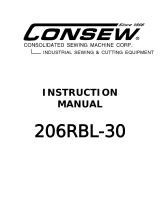 Consew 206RB-5 User manual
Consew 206RB-5 User manual
-
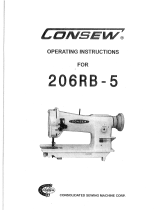 Consew 206RB-5 User manual
Consew 206RB-5 User manual
-
Mitsubishi Electric LT2-2250-B1T User manual
-
Siruba C007KP Instruction book
-
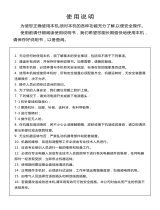 ZOJE ZJ5303A-W-BD Parts Manual
ZOJE ZJ5303A-W-BD Parts Manual
-
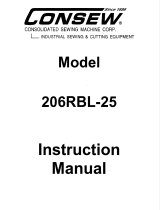 Consew 206RBL-25 User manual
Consew 206RBL-25 User manual
-
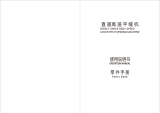 ZOJE ZJ9513-G Parts Manual
ZOJE ZJ9513-G Parts Manual
-
HIGHLEAD GC618-1 D2 User manual
-
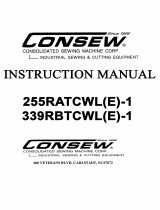 Consew 339RBATCL User manual
Consew 339RBATCL User manual
-
Reliable 3200TN User manual




















































